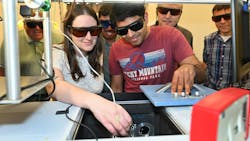Scientists Develop Photosynthesis-Inspired Method to Convert CO2 Into Industrial Chemical
U.S. Department of Energy chemists have designed a new way to convert abundant carbon dioxide into formate using a process that’s similar to photosynthesis.
Formate (HCO2-) is an industrial chemical used as a fuel, antibacterial/antifungal agents and in pharmaceutical manufacturing.
The scientists from the Brookhaven National Laboratory in New York used a light-activated metal-centered catalyst to facilitate the transfer of electrons and protons needed for the chemical conversion, according to a June 16 news release from the lab.
“In both our reaction and photosynthesis, the transfer of protons and electrons is promoted directly or indirectly by light,” said Sai Puneet Desai, the lead author of a paper describing the research just published in the Journal of the American Chemical Society.
It’s a way of storing light energy in chemical bonds, co-author Andressa Müller added.
These types of CO2 conversions typically require binding CO2 to a metal center on the catalyst, leaving empty spaces for other competing molecules to come in and react with the metal.
“That can lead to decomposition of the catalyst, and it limits the selectivity over the kind of products you can make,” said group leader Javier Concepcion.
To control the selectivity and avoid unwanted side reactions, the team surrounded their metal center with ligands.
“The catalyst is like a flower: The metal is the center of the flower, and the petals are the ligands,” Müller said. “We can tune the properties of the catalyst with these ligands, and all the chemistry takes place at one of the ligands instead of at the metal.”
In this new mechanism, all the binding sites on the metal are occupied, fully protecting the metal from engaging in unwanted side reactions. And by precisely designing the ligands, the scientists can carefully control the product.
“This mechanism is highly selective; only formate is produced,” Concepcion said. “Oftentimes, there is competition toward making hydrogen, and/or making carbon monoxide, and sometimes it’s difficult to control which of these products you are making. But to make these products, you need open sites at the metal center. In this case, because the mechanism is ligand-based, there is no chance for these other products to be generated.”
Once the electrons and protons are delivered to the CO2, all components of the system can revert to their original forms to be used again.
“This recyclability is really important because we want to make this system as efficient as possible, and we don’t want to introduce waste,” Desai said.
Photo Caption: Andressa Müller and Sai Puneet Desai use an infrared spectrometer in the Brookhaven Lab Chemistry Division to analyze a sample containing a photosensitizer, their catalyst, and other reaction components.
About the Author
Jonathan Katz
Executive Editor
Jonathan Katz, executive editor, brings nearly two decades of experience as a B2B journalist to Chemical Processing magazine. He has expertise on a wide range of industrial topics. Jon previously served as the managing editor for IndustryWeek magazine and, most recently, as a freelance writer specializing in content marketing for the manufacturing sector.
His knowledge areas include industrial safety, environmental compliance/sustainability, lean manufacturing/continuous improvement, Industry 4.0/automation and many other topics of interest to the Chemical Processing audience.
When he’s not working, Jon enjoys fishing, hiking and music, including a small but growing vinyl collection.
Jon resides in the Cleveland, Ohio, area.

